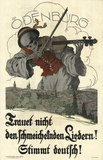The collapse of the Habsburg monarchy meant that the question of future nationality also became acute for the German-speaking population of western Hungary.
In the course of November 1918 both German-Austria and Hungary proclaimed themselves republics and both laid claim to German West Hungary. In the declaration of state of 22 November 1918 the Provisional National Assembly of German-Austria, referring to the ‘right of peoples to self-determination’ proclaimed that the counties of Pressburg/Pozsony vármegye, Wieselburg/Moson vármegye, Ödenburg/Sopron vármegye and Eisenburg/Vas vármegye were part of the newly formed republic. While many sections of the ethnic German population of western Hungary toyed with the idea of union with German-Austria, others advocated autonomy for the region within Hungary.
The Austrian delegation sent to Paris, which was led by Karl Renner, informed the Allies that it was in favour of a plebiscite being held in German West Hungary. However, on 10 September the treaty of Saint-Germain allocated the area to the Republic of Austria (the name ‘German-Austria’ having been forbidden) without a plebiscite. The Allies had several motives for taking this decision: on the one hand ethnic boundaries as well as the economic links between Vienna and this rural region were taken into consideration. On the other there was the desire to weaken the soviet republic in Hungary by ceding German West Hungary to Austria.
Hungary, which after the overthrow of the soviet republic was led by the conservative Miklós Horthy, put up unremitting resistance at political and diplomatic levels to the clauses regulating frontiers in the treaties of Saint-Germain (for Austria) and Trianon (for Hungary). In the following two years it insisted vehemently on keeping the area of German West Hungary under Hungarian administration. When the Austrian army tried to occupy this territory on 28 August 1921 it was forcibly prevented from doing so by Hungarian guerrillas. Hungary would only agree to hand over Burgenland to Austria if it in turn gave up Ödenburg/Sopron. The conflict was finally resolved in the Venice protocol of 13 October 1921. In this the Hungarian government committed itself to the withdrawal of its armed troops and to ceding Burgenland to Austria. Austria had for its part to conduct a plebiscite in Ödenburg/Sopron and eight surrounding communities.
German West Hungary, which since 1919 had increasingly referred to itself as ‘Burgenland’, was officially incorporated into the republic of Austria on 5 December 1921. The plebiscite was held in Ödenburg/Sopron on 14 and 15 December and resulted in the territory remaining with Hungary. Although there were clear irregularities in the voting – with strangers, soldiers, students and even already deceased citizens being included in the electoral registers, the Allies did not revise the outcome of the plebiscite.
Translation: Leigh Bailey
Ernst, August: Geschichte des Burgenlandes, 2. Auflage, München 1991
Goldinger, Walter/Binder, Dieter A.: Geschichte der Republik Österreich 1918-1938, München 1992
Hanisch, Ernst: Österreichische Geschichte 1890-1990. Der lange Schatten des Staates. Österreichische Gesellschaftsgeschichte im 20. Jahrhundert, Wien 1994
Rásky, Béla: Vom Schärfen der Unschärfe. Die Grenze zwischen Österreich und Ungarn 1918-1924, in: Konrad, Helmut/Maderthaner, Wolfgang (Hrsg.): Das Werden der Ersten Republik … der Rest ist Österreich. Bd. I, Wien 2008, 139-158
Vocelka, Karl: Geschichte Österreichs. Kultur – Gesellschaft – Politik, 3. Auflage, Graz/Wien/Köln 2002
Widder, Roland: 90 Jahre Republik – und das Burgenland dabei!, in: Karner, Stefan/Mikoletzky, Lorenz (Hrsg.): Österreich. 90 Jahre Republik. Beitragsband der Ausstellung im Parlament, Innsbruck/Wien/Bozen 2008, 181-192
-
Chapters
- The High Price of Peace
- Tyrol Is Divided
- Burgenland Is Gained
- The defensive campaign in Carinthia and the plebiscite on 10 October 1920
- Losing Southern Styria
- Fixing the Northern Frontier
- Austrian Federal Province or Swiss Canton?
- Austrian attempts to unite with Germany from the founding of the republic to the referendums in Tyrol and Salzburg in 1921








